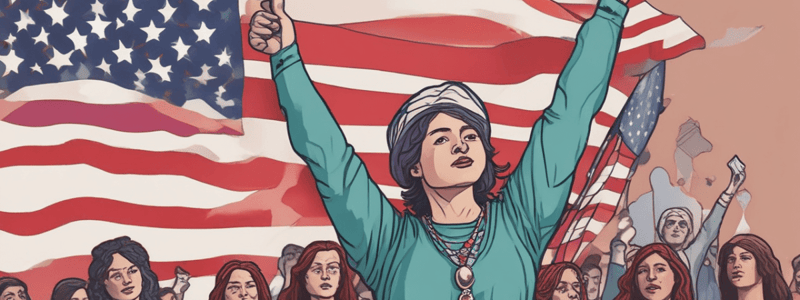Podcast
Questions and Answers
What was the main focus of the Declaration of Sentiments?
What was the main focus of the Declaration of Sentiments?
- Fighting for women's right to education
- Fighting against slavery
- Fighting for women's right to vote (correct)
- Fighting to better the lives of women economically
When was the 19th Amendment to the U.S. Constitution passed?
When was the 19th Amendment to the U.S. Constitution passed?
- 1919 (correct)
- 1917
- 1848
- 1920
Who was an organizer of the Seneca Falls Convention?
Who was an organizer of the Seneca Falls Convention?
- Lucretia Mott (correct)
- Elizabeth Cady Stanton
- Susan B. Anthony
- Sojourner Truth
What was the significance of the Seneca Falls Convention?
What was the significance of the Seneca Falls Convention?
What was the main goal of the early Women's Movement?
What was the main goal of the early Women's Movement?
What was another name for the early Women's Movement?
What was another name for the early Women's Movement?
What was the significance of the Seneca Falls Convention?
What was the significance of the Seneca Falls Convention?
Where was the Seneca Falls Convention held?
Where was the Seneca Falls Convention held?
What was the outcome of the Women's Movement after the passage of the 19th Amendment?
What was the outcome of the Women's Movement after the passage of the 19th Amendment?
Who were the main organizers of the Seneca Falls Convention of 1848?
Who were the main organizers of the Seneca Falls Convention of 1848?
Which of the following was NOT a cause advocated by Elizabeth Cady Stanton?
Which of the following was NOT a cause advocated by Elizabeth Cady Stanton?
What helped Lucretia Mott develop her excellent speech-giving skills?
What helped Lucretia Mott develop her excellent speech-giving skills?
Why did the resolution for women's voting rights almost not pass at the Seneca Falls Convention?
Why did the resolution for women's voting rights almost not pass at the Seneca Falls Convention?
What was Mary M'Clintock's role at the Seneca Falls Convention?
What was Mary M'Clintock's role at the Seneca Falls Convention?
Why was Susan B. Anthony not directly involved in the Seneca Falls Convention?
Why was Susan B. Anthony not directly involved in the Seneca Falls Convention?
Flashcards are hidden until you start studying
Study Notes
The Seneca Falls Convention
- The first convention in the United States to address women's rights, held in 1848.
- Around 300 people attended the convention.
- The convention marked the beginning of the Women's Movement, which fought for economic, social, and political equality for women.
The Declaration of Sentiments
- A document drafted just before the convention, outlining the main ways women were oppressed and the goals of the Women's Movement.
- The document was presented to the assembly and adopted at the convention.
- It focused on fighting for women's right to vote, which eventually led to the passage of the 19th Amendment in 1919.
Key Players
- Elizabeth Cady Stanton: main organizer, writer, and speaker of the early Women's Movement, advocating for women's right to vote, property rights, and legal rights.
- Lucretia Mott: main organizer, Quaker minister, and advocate for women's rights, using Biblical scripture to support her arguments.
- Frederick Douglass: anti-slavery activist, author, and advocate for women's rights, who convinced the assembly to pass the resolution for women's voting rights.
Significance
- The Seneca Falls Convention spearheaded a decades-long early Women's Movement, resulting in important advances in women's rights.
- The movement eventually culminated in the passage of the 19th Amendment, granting women the right to vote.
- The convention also influenced future social movements in the United States and abroad.
Convention Details
- Held from July 19-20, 1848, at the Wesleyan Chapel in Seneca Falls, New York.
- The convention consisted of six sessions of lectures, debates, and discussions, divided between two days.
Studying That Suits You
Use AI to generate personalized quizzes and flashcards to suit your learning preferences.




